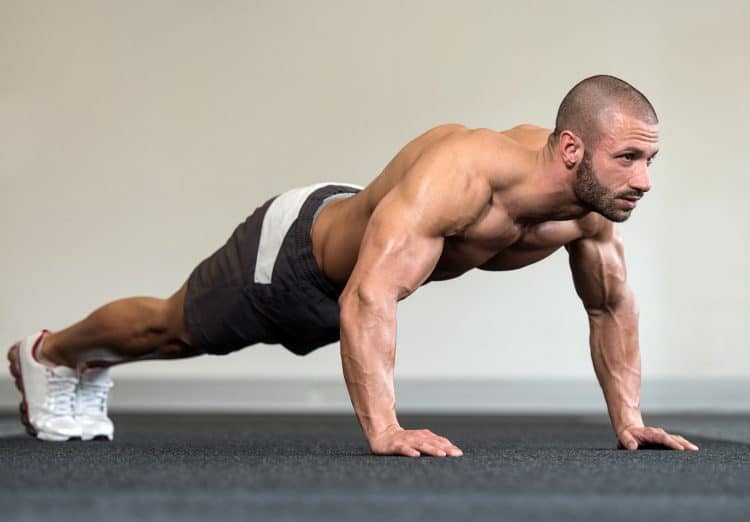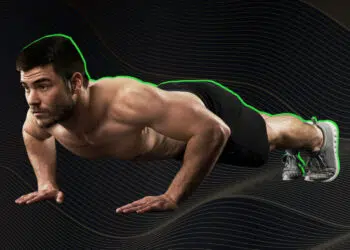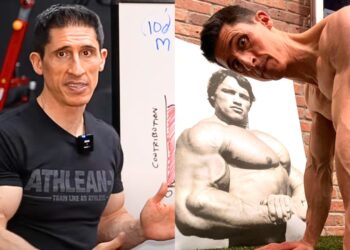If you’re reading this hoping to learn the difference between press-ups and push-ups, I’ve got bad news for you – they’re the same thing!
Press-ups are what British English speakers call push-ups. It’s an example of how exercise names sometimes vary by region. The rest of the world uses the term push-ups, but if you’re reading something written by a Brit (like me!), you may see the term press-up used instead.
In fact, it’s taken me years to break the habit of calling push-ups by their British name. I’ve confused a lot of readers and magazine editors in the past by using the less-popular term.
That said, after working in the international fitness industry for so long, I now automatically use the term push-ups, and I think it’s time for the UK to retire the term press-up to avoid further confusion.
In fact, the term push-up outdates press-ups by about 50 years, so it really deserves to be the name of choice for the world’s favorite bodyweight exercise.
So, the terms press-ups and push-ups are interchangeable, and there is no discernable difference.
Level Up Your Fitness: Join our 💪 strong community in Fitness Volt Newsletter. Get daily inspiration, expert-backed workouts, nutrition tips, the latest in strength sports, and the support you need to reach your goals. Subscribe for free!
What’s so Great About Push-ups, Anyway?
Now you are reading this, I’d like to take the opportunity to remind you why the humble push-up is such a great exercise. After all, a lot of experienced exercisers are very quick to dismiss the humble push-up and prefer to do bench presses instead.
Contrary to popular opinion, push-ups are NOT a beginner exercise. Everyone who works out should include them in their workouts.
Push-ups are great because:
You can do them anywhere and anytime
No time to work out? Can’t make it to the gym? Long queue for the bench press? No problem! Pump out a few sets of push-ups instead! With no equipment required, you can do push-ups anywhere and anytime. They’re the ultimate excuse-free upper body exercise. There really is no excuse for not doing push-ups.
They’re highly functional
The push-up is more than just an upper-body exercise. Push-ups involve your whole body. To do push-ups correctly, you need to stabilize your shoulder girdle, brace your core, and use your legs while you crank out your reps.
This means that push-ups are very functional. In contrast, movements like the bench press and chest press are far less functional. The bench or the machine you’re using supports your body, essentially removing your legs and core from the exercise.
If you want to train your body as it works in nature, i.e., as one cohesive unit and not a bunch of separate parts, the push-up is one of the best ways to do it.
Push-ups are shoulder-friendly
The bench press is probably the most popular upper body exercise. But, they can also be hard on your shoulders, and a lot of benchers suffer from chronic shoulder pain. That’s because the bench on which you lie stops your scapulae from moving and forces your shoulders to move in a sub-optimal way.
In contrast, your shoulder blades are free to move during push-ups, which means there is less stress on the shoulder joint. So, if bench presses bother your shoulders, you may find that you can do push-ups without a problem.
Push-ups are a bonafide bench press booster
When it comes to improving your performance of any exercise, workout frequency matters. One training session per week won’t cut it. Instead, you need to hit the muscle groups you want to develop several times per week.
If you want to boost your bench press performance, push-ups can help. In fact, doing an extra 50-100 push-ups per day will help you bench more weight and do more reps.
Push-ups use the same muscles and basic movement as bench presses, but because they’re easier on your joints and you can do them anywhere, you can train your chest and triceps more often.
That makes push-ups the perfect bench press assistance exercise.
There are loads of different push-up variations to try
Whether you are a beginner, intermediate, or advanced exerciser, there is a push-up variation for you! With dozens of different types of push-ups to try, you should have no problem making your push-up workouts challenging and interesting. Regardless of what you are training for, there is a push-up variation that’ll help you reach your fitness goal.
How to Do Push-ups
To enjoy all the benefits that push-ups have to offer, you need to do them correctly. Common push-up faults include:
- Not lowering your chest close enough to the floor
- Craning your head downward
- Dropping or raising your hips out of neutral alignment
- Incorrect hand placement
- Losing core tension
So, to make sure you know how to do push-ups correctly, here’s a step-by-step guide to this fantastic bodyweight exercise!
- Kneel down and place your hands on the floor. They should be roughly shoulder-width apart with your fingers pointing forward.
- Brace your core and walk your feet back until your legs are straight. Your shoulders, hips, and legs should form a straight line, and your arms should be vertical.
- Pull your chin in so your neck is long and neutral. Set your shoulders down and back.
- Keeping your body straight, bend your arms and lower your chest (not your head!) down to within an inch of the floor. Tuck your elbows down and in as you descend.
- Push the floor away, extend your arms, and return to the starting position. Extend your arms without locking your elbows.
- Inhale as you descend, and exhale as you push back up.
If full push-ups are too demanding for you, bend your legs and rest on your knees. This takes some of the weight off your hands. The closer you move your knees toward your hands, the easier push-ups become, so adjust your position according to your current abilities.
7 of the Best Push-up Variations
Have you mastered the standard push-up? Good for you! Keep challenging yourself with these awesome push-up variations.
1. Paused push-up
Paused push-ups make every rep a little longer and, therefore, more challenging. Also, without the stretch reflex at the bottom of each rep, you’ll need to work harder to push yourself back up. This not only increases muscle engagement but also helps develop explosive power.
How to do it:
- Adopt your usual push-up position. Brace your core and pull your shoulders down and back.
- Bend your arms and lower your chest to within an inch of the floor.
- Pause and hover in this position for 3-5 seconds.
- Drive yourself back up to full arm extension and repeat.
2. 1 ½-rep push-up
1 ½ rep push-ups keep your pecs under tension for longer. They produce a deep burn and pump, and you’ll really feel your pecs working.
How to do it:
- Adopt your usual push-up position with your arms and legs straight, and core braced.
- Bend your arms and lower your chest to within an inch of the floor.
- Extend your arms and push yourself halfway back up.
- Lower your chest to the floor again.
- Extend your arms and come all the way up.
- That’s one rep; keep going!
3. Deficit push-up
With regular push-ups, your range of motion is limited by the floor. Deficit push-ups allow you to descend further, which means each rep involves more work and a longer time under tension than push-ups done with your hands on the floor. Both of these factors may produce greater hypertrophy or muscle growth.
How to do it:
- Create a deficit by placing two dumbbells on the floor, a couple of bumper plates, yoga blocks, or by using push-up handles or parallettes. Whatever you use should be slightly wider than shoulder-width apart.
- Squat down and place your hands on the raised implements.
- Walk your feet out and back so that your legs, hips, and shoulders form a straight line. Brace your core and pull your shoulders down and back. Tense your legs and glutes, too. Tuck your chin in and lengthen your neck.
- Bend your arms and lower your chest down between your hands. Your range of motion will depend on your shoulder flexibility and joint health. However, take care not to hyperextend your shoulders by descending too far.
- Keep your upper arms close to your sides and your wrists straight.
- Push yourself back up, reset your shoulders, and then descend into another rep.
4. Decline push-up
One of the simplest ways to make push-ups more demanding is to raise your feet and do decline push-ups. This puts more weight on your arms and also puts your body into a flatter position, so you’ll be working your mid-chest more. Regular push-ups tend to emphasize your lower pecs.
How to do it:
- Set up for push-ups as usual but place your feet on a knee-high chair or bench. Brace your abs and pull your shoulders down and back.
- Without dropping your hips out of alignment, bend your arms and lower your chest to within an inch of the floor.
- Push yourself back up and repeat.
5. Resistance band push-up
Powerlifters and bodybuilders use resistance bands in conjunction with squats, bench presses, and deadlifts to increase the overload as they extend their limbs. You can use this same training method, called accommodating resistance, with push-ups. Start with a light, loop-type band, and progress to a thicker band as your strength increases.
Level Up Your Fitness: Join our 💪 strong community in Fitness Volt Newsletter. Get daily inspiration, expert-backed workouts, nutrition tips, the latest in strength sports, and the support you need to reach your goals. Subscribe for free!
How to do it:
- Hold a loop-type resistance band across your upper back. Get down into the push-up position. Brace your core and pull your shoulders down and back.
- Bend your arms and lower your chest to within an inch of the floor.
- Push yourself back up against the resistance provided by the band.
6. Hand-release push-up
Hand-release push-ups are so-called because you lift your hands off the floor at the bottom of each rep. Because you can only do this with your chest resting on the floor, hand-release push-ups force you to use a full range of motion, making push-ups much more cheat-proof.
As well as ensuring you use a full range of motion for every rep, hand-release push-ups increase upper back muscle activation, making them a more balanced exercise. Finally, by lying flat between reps, each rep starts from a dead stop, which increases muscle activation.
How to do it:
- Kneel down and place your hands flat on the floor, slightly wider than shoulder-width apart. Your fingers should be pointing directly forward. Walk your feet back, making sure your body is straight and rigid; brace your core. Look straight down at the floor.
- Bend your arms and, under control, lower your chest to the floor. Keep your body tense and straight.
- Pull your shoulders down and back and lift your hands a few inches off the floor. Imagine you are doing a bent-over barbell row. Do not arch your lower back.
- Place your hands back on the floor and push yourself back up to return to the starting position. Extend your arms explosively to overcome inertia and increase muscle activation.
7. Plyometric push-up
Plyometric push-ups are good for anyone who wants to throw further or punch harder. This exercise could also help boost your bench press performance, increasing your speed off your chest. For safety, do this exercise on a forgiving surface, such as a gym mat.
How to do it:
- Adopt the push-up position with your arms and body straight, and core braced.
- Bend your arms quickly, stopping with your chest just above the floor.
- Powerfully extend your arms and drive your upper body up, so your hands leave the floor. Clap your hands if you wish.
- Land on slightly bent elbows and repeat.
- Make this exercise easier by bending your legs and resting on your knees. Alternatively, you can do it with your hands on a raised surface, e.g., an exercise bench.
Push-up Workouts
While there is nothing wrong with doing a few straight sets of push-ups, that kind of training approach can soon get boring, and boring workouts tend not to be very productive. So, challenge yourself with these tried-and-tested push-up workouts.
While these workouts were mostly designed to be done with standard push-ups, there is nothing to stop you from using one of the seven push-up variations outlined above instead if you want an even greater challenge.
1. EMOM push-up ladder
EMOM stands for Every Minute on the Minute, and is a popular CrossFit training method. With EMOM, you start your sets at the top of each minute. After doing your reps, whatever time is left is your rest period.
How to do it:
For this workout, do two push-ups on the first minute, four push-ups on the second minute, six push-ups on the third minute, and so on. Continue until you reach failure.
2. Burpee push-up ladder
No time for a long workout? Try this push-up/burpee ladder. It’s over and done in ten minutes or less, but still pretty challenging.
How to do it:
- Begin in a standing position
- Drop down to the floor and do one push-up
- Stand back up quickly
- Drop back down and do two push-ups
- Stand back up
- Drop back down and do three push-ups, then stand back up
Repeat this pattern until you reach 10 reps, having completed a total of 55 push-ups, standing up between sets, and keeping your rests as short as possible.
3. Tabata push-ups
Tabatas are a form of high-intensity interval training, or HIIT for short. But, you can also use Tabatas for strength and conditioning exercises like push-ups. Over and done in four minutes, this is a great way to pump up your pecs without resorting to long workouts.
How to do it:
- Push-ups – maximum reps in 20 seconds
- Rest 10 seconds
- Repeat for eight sets to total four minutes
4. Deck of cards push-up workout
This workout introduces an element of randomization into your training. Get a deck of cards and remove one suit, e.g., hearts. Give those heart cards a shuffle, and then place them face down.
How to do it:
Turn over the top card. Its value is the number of push-ups you need to do. Pump out the required number of reps and then turn over the next card. Work your way through the entire suit as fast as you can. Aces are worth one, while jacks are 11, queens are 12, and kings are 13.
5. 5-minute push-up challenge
This timed challenge involves doing as many push-ups as possible in the allotted time. It’s an excellent way to test your push-up prowess, as you can repeat this workout every few weeks and compare your performance to your previous score.
How to do it:
Set a timer for five minutes and do as many perfect push-ups as you can in that time. Only count “good” reps, i.e., your chest touches the floor, and your arms are straight between reps. Rest when you need to but remember that the clock is always ticking!
6. Push-up medley
Are you unable to decide between all the different types of push-ups? This workout combines several variations to make one challenging workout!
How to do it:
Complete the following sequence as fast as you can…
- Plyometric push-ups x 10
- Decline push-ups x 10
- Paused push-ups x 10
- 1 ½-rep push-ups x 10
- Regular push-ups x 10
Rest a moment and then repeat the entire series twice more to total three sets.
7. Race to 100 push-ups
This workout is similar to #5. But, instead of trying to complete as many reps as possible in a predetermined time, you’ll be doing a set number of reps as fast as you can.
How to do it:
Start your stopwatch and start pumping out push-ups. Rest when you need to, but remember the clock is ticking. Try to complete all 100 reps in the shortest possible time, only counting perfect push-ups.
Learn More About Push-Ups:
- How To Do Push-Up
- Calories Burned Push-Ups Calculator
- Intense Push-Up Variations for Bodybuilders
- Next Level Push-Up Variations For Mass, Strength, and Performance
- Diamond Push-Ups – Muscles Worked, How-To, Benefits, and Alternatives
- Hand-Release Push-Ups Exercise Guide
- Push-up Board — How To Use, Benefits, and Workouts
Press-Ups Vs. Push-Ups – Wrapping Up
So, there is no difference between press-ups and push-ups. The term press-up is just an Anglicism for push-ups. They’re the same exercise with an alternative name.
Regardless of what you call them, the classic push-up and its many variations are some of the most productive exercises around. Whether you want to build muscle, get stronger, tone up, burn fat, or just get fit, push-ups can help.
Everyone who works out should do push-ups, regardless of whether they are a beginner, intermediate, or advanced. Squats are often called the king of exercises, but maybe it’s push-ups that deserve that title…
Now drop down and give me 20!
Interested in measuring your progress? Check out our strength standards for Bench Press, Push Ups, Deadlift, and more.









